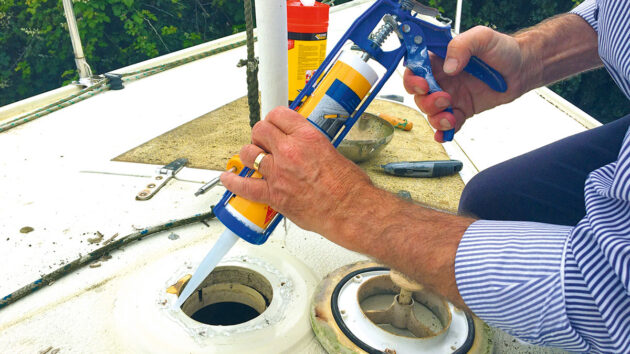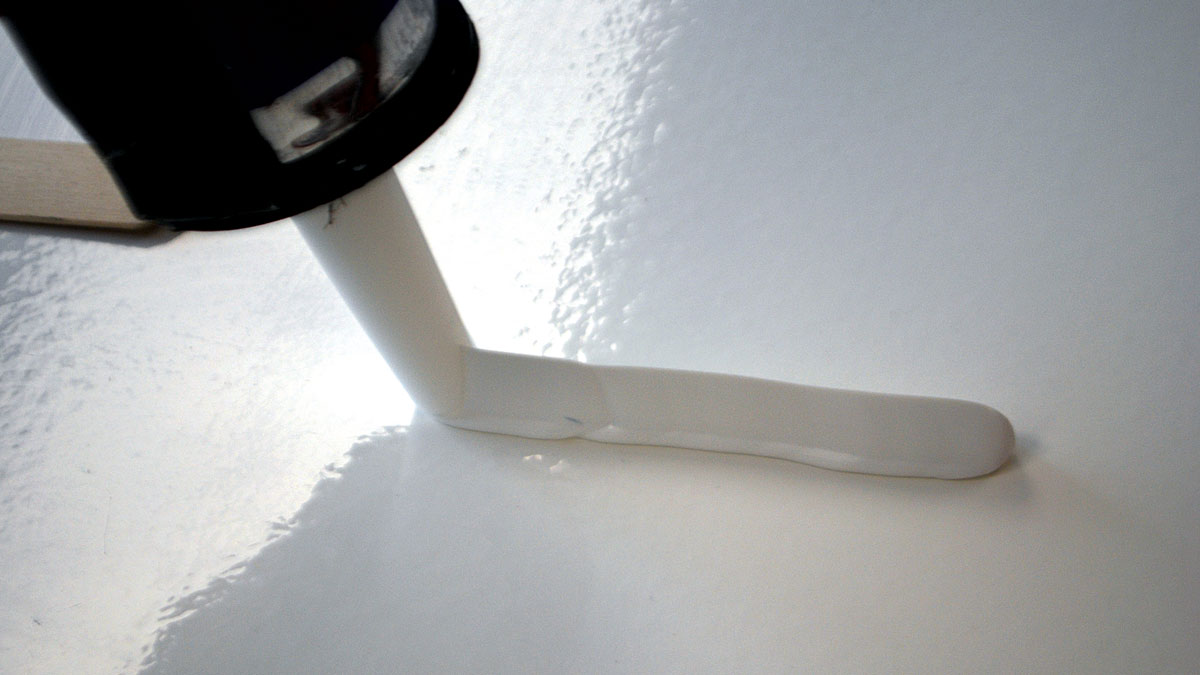With help from adhesive and sealant expert Laurie Brebner, PBO’s Ali Wood explains which works best for different jobs on a boat
Have you ever emerged on deck after a rough passage only to find it’s dryer above than below?
Leaky windows, hatches and deck fittings can happen on any boat, but in extreme cases, water ingress can lead to structural damage.
Understanding marine sealants and how to apply them is a useful skill for all boat owners.

Applying a bead of Sikaflex before reinstalling a deck fitting
Marine sealants are designed to keep water out. They can also be used to block sound and heat, and, unlike household products, will withstand harsh UV conditions.
Used for sealing gaps and holes, sealants tend to be flexible, making them useful for joints where contraction or expansion may occur.
However, the term is also used for bonding or adhesive products, so choosing the right sealant for the job – whether you’re caulking, levelling, bedding, sealing or bonding – takes proper research.
You need to consider what types of materials will be bonded together, if the bonded surfaces will come in contact with water, and if you’ll need to remove the sealant down the line.
Sticking or sealing?
Most marine sealants come as a single-component product, but there are some strong adhesives, such as epoxy, that come in two-component packs and need to be mixed together.
Anything that’s going through the gelcoat – a screw hole, for example – is a potential source of water ingress, and will always need a good sealant.

Old deck fittings can be a source of leaks
However, choose carefully between an adhesive (that will bond two substrates together) and a sealant, which will create a gasket seal to stop water and general contamination ingress, and is often used with an additional fastening.
Laurie Brebner is a specialist at Marine and Industrial, a family-run business that distributes adhesives, sealants, epoxies and coatings to the trade.
Laurie often finds that boat owners confuse the two.
“The key question here is, how likely is it that the fitting will be removed in the future? Having built and refitted boats from scratch, I’m always mindful of the next person who has to take the fitting off!”

Some surfaces work best with specialist adhesives
Laurie cites a cleat, fairlead or stanchion plate, for example.
“Over time, these get bent and might need to be replaced. They’re held down by a bolt or decent size screw, but if anyone’s used an adhesive, such as Sika 291, not only will the part be all beat up, but you’ll end up having to drive a wedge into it to get it out and do a gel coat repair too. Really, you should be using something like Arbormast BR, SikaLastomer 710 (butyl rubber) or – where UV exposure is likely – Sika 591.
“For skin fittings, on the other hand, which are a pretty serious job and something you don’t want to change too often, Sika 291 is ideal and suitable under the waterline.”
When marine sealants don’t work
A sealant will usually fail because it’s the wrong product or has been applied incorrectly; either not enough has been used, or the parts have been over-clamped, thus squeezing most of the sealant out from the middle.
On occasions, some marine sealants have not been left to adequately cure before being immersed in water or exposed to weather.

This Maxi 84 window is mechanically bonded, so it does not require a strong adhesive too
On keel joints, for example, this might leave a ‘sticky’ line between the hull stub and the top of the keel.
This can also be caused by a reaction with the solvents in antifoul primers, especially where the sealant hasn’t been allowed to cure.

Sealant, such as this between the keel and hull, can be affected by solvents in antifoul
Be sure to give any sealant sufficient time to skin off and start curing before over-painting with solvent-based coatings.
Types of marine sealants

Butyl
Non-adhesive, and with similar consistency to chewing gum, butyl, or ‘butyl rubber’, can easily be removed and reapplied.
It’s less messy than traditional sealants, but it is susceptible to UV damage and you can pick it off.
Arbomast BR sealant, for example, is an excellent, permanently flexible UV-resistant sealant that can be used for sealing windows and hatches.
“It’s similar to the old window putty, an oil-based mastic,” says Laurie. “Butyl forms a wonderful bedding compound and gasket seal, and never cures. When you take the screws and bolts off, you can literally put a screwdriver in the gap and prise it off, or use a scraper and white spirit without damaging the surface.”
Brands: Arbormast BR, SikaLastomer 710, Everbuild Butyl Rubber Sealant 145
Silicones
Mildly adhesive, as well as UV and heat-resistant, silicones are great insulators and excellent for sealing.
However, they don’t bond well to wood.

Hatch seals degrade after time and are a common source of water ingress
Geobond, for example, is a single-pack flexible silicone sealant specifically formulated for creating watertight gaskets, and is ideal for sealing around otherwise secured hatches, portlights and windows.
Brands: Geocel Geobond, Dowsil 795, Aquaseal mSeal 595
Polyurethanes
Polyurethanes are extremely adhesive when used on the correct surface and can be used below the waterline.
Some are UV-resistant, though not all types, so be aware of what you’re using and in what application.
“Polyurethanes like a damp environment,” says Laurie. “They cure by grabbing moisture from the air or even underwater. If you’ve got wet decks, Sikaflex will work well.”
Polyurethane sealants dry hard, and although they’re good with wood, if you’re using them with organic glass (ie. plastic) windows, there are specific products that are designed to allow for thermal expansion.
Sikaflex 295 UV and Bostik MSR-CA (a hybrid) are ideal, but the specified primers MUST be used, as well as there being a UV blocking frit applied on the window (usually by the window manufacturer).
Brands: Sikaflex 291i & 295 UV, 3M Marine Adhesive Sealant 5200, Star Brite 8200 Marine Sealant
Polysulphides
Polysulphides are also very adhesive and good for all-purpose repairs.
They have excellent resistance to UV, fuel and oil, as well as protecting against corrosion and vibrations.
The downside to polysulphides is that they can’t be used on plastic surfaces (especially acrylics such as Plexiglass and Perspex) as they cause many types of plastic to harden and split.
Arbokol 1000, for example, is a single-component polysulphide sealant which creates structural joints between wood, GRP and other porous materials.
“Polysulphides are quite old technology now, and there aren’t many around, but Arbokol 1000 is a particularly good one that lots of people use,” says Laurie.
Brand: Arbokol 1000
Hybrid sealants
Hybrids make up the majority of sealants on the market. These take the best elements of existing sealants and mix them together so you can choose the perfect product for your job.
If you need something specialist: to seal an oven gasket, for example, which requires extreme heat-resistance, or a heads skin fitting, which will be subject to sewage effluent, you’ll probably opt for a hybrid.
Be sure to check the instructions on the bottle; some products can’t resist organic acids or solvents, while others might not bond to plastics.
Bostik MSR-CA is very UV-resistant and adhesive, and is based on MSP (modified silane polymer). It cures quickly and remains elastic from -40°C to +100°C.
For tiny cracks and gaps, Captain Tolley’s Creeping Crack Cure is a low viscosity copolymer adhesive which penetrates and seals hairline cracks using capillary action.
Laurie also recommends Sika 591. “Whereas 291 and most of the Sika products are polyurethanes, 591 is an MSP, a hybrid which is UV stable and over-paintable with single- and two-pack paints,” he says.
Brands: Bostik Simson MSR-CA, Captain Tolley’s Creeping Crack Cure, Sika 591
Structural sealants
These are almost always two-part adhesives and range from epoxy adhesives to MMAs.
They have very high bond strength and variable hardeners, which determine cure times.
Structural sealants can be used for anything from basic repairs to the construction of high-performance composites.

Epoxies need to be carefully mixed
They’re particularly good with dissimilar substrates such as metal to GRP, but degrade in UV and heat.
“Epoxies generally like drier conditions, but an excellent epoxy which is tolerant of moisture is the West System G-Flex range,” advises Laurie. “It’s available in two types: the 650 is runny – a two-part resin and hardener mix – while the 655 is pre-thickened, so it has colloidal silica added, and feels like peanut butter; that’s a one-to-one mix. Both will bond to damp timber and all sorts of substrates.
“Methyl methacrylate (MMA) two-part adhesives are also very strong. Plexus is a well-known and widely used brand, which comes with different-viscosity hardeners that determine the curing speed.”
Brands: West System G-Flex, Plexus, Proset, SikaFast
Top tips

Wonder Wipes are a quick and easy way to clean the surface area
- Before starting work, remove all old sealant and clean areas with acetone or white vinegar. Wonder Wipes are also good for a quick clean-up.
- If you’re swapping over from polyurethane to silicone, you need to be especially careful that every last trace of the old sealant is removed with a scraper and acetone; otherwise, the seal could break down.
- Always be generous with the sealant. As you tighten screws or bed-in fittings you should see it popping up around the edges. Don’t forget to squeeze it into screw holes.
- Read the instructions and prepare thoroughly before starting work. Be aware of the curing times and how long you have to complete the job, as well as the time you need to leave it afterwards.
- Cut the nozzle at an angle of 45° – the bigger the bead you require, the higher up the nozzle you cut it
- Windows always take longer than expected. Finish one before starting another so you don’t end up having to tarp the whole boat.
- Snotter trick – hang your sealant gun down to stop it from curing.

Hang your sealant gun down to stop the sealant from curing
10 things to consider with marine sealants
Sealants can solve a huge number of issues in boating, but one size definitely does not fit all! Here are the things to ask yourself when choosing the right one:
- Chemical resistance: does it resist commonly found chemicals at sea?
- Compatibility: does it work with the substrates you’re bonding, be that wood, metal, GRP, etc?
- Waterproofing: it’s critical that water won’t infiltrate the bond
- Saltwater protection: some sealants won’t be suitable for decks and below the waterline
- UV protection: will it endure prolonged exposure to the sun?
- Durability: can it sustain performance in hostile marine conditions and under vibration and impact?
- Fast curing: fixes at sea require fast-drying sealants
- Flexibility: does it need to move freely without damaging the bond?
- Bonding strength: how secure does the sealant need to be? Might you replace the fitting in future?
- Fit for purpose: consider a specialist sealant for unique applications (ie. fittings subjected to extreme heat, movement or particular chemicals)
How to use sealants for fixing leaks – PBO Project Boat restoration
A downpour of rain shows that making PBO Project Boat Maximus watertight is a priority, so Ali Wood gets some…
Polyurethane vs silicone sealants: Which is best for use on boats?
They’re not the same as adhesives but some sealants – such as Sikaflex – do have adhesive properties. There are…
9 tips and tricks for applying sealant
Premium bonding: Ben Meakins outlines some techniques for getting the most out of sealant without ending up covered in the…
Snotter trick – how to prolong the life of your sealant
Next time you work with a marine sealant, be sure to leave it hanging, and don’t be tempted to remove…
Want to read more articles like The best adhesives and sealants for boat jobs?

A subscription to Practical Boat Owner magazine costs around 40% less than the cover price.
Print and digital editions are available through Magazines Direct – where you can also find the latest deals.
PBO is packed with information to help you get the most from boat ownership – whether sail or power.
-
-
-
- Take your DIY skills to the next level with trusted advice on boat maintenance and repairs
- Impartial, in-depth gear reviews
- Practical cruising tips for making the most of your time afloat
-
-
Follow us on Facebook, Instagram, TikTok and Twitter








